Asian food has cemented its place at the top of the global culinary scene thanks to cultural influence, culinary innovation, and economic factors.
Notable among these is Chinese cuisine, which is served in more than 24,000 Chinese restaurants in the US alone.
In fact, a 2018 study by Food Research International found that Asian cuisine, mainly Chinese and Japanese, remains at the forefront of global culinary trends due to innovative cooking techniques and fusion cuisine, blending tradition with modernity.
If you’re curious about the industry and its culture, opening a restaurant can be a rewarding venture.
Of course, it will require you to do some homework: researching, planning, and even incorporating various innovations, be it a global fusion of flavors or technologies like QR code menu ordering or self-service equipment, to keep your business in the loop of the current trends while maintaining the authentic elements of the dishes.
To prepare you for this exciting culinary journey that is deeply connected to culture, we’ve prepared this ultimate guide on how to start your restaurant and sustain it for long-term business success.
Table of Contents
ToggleLooking at the numbers: How profitable is a Chinese restaurant?
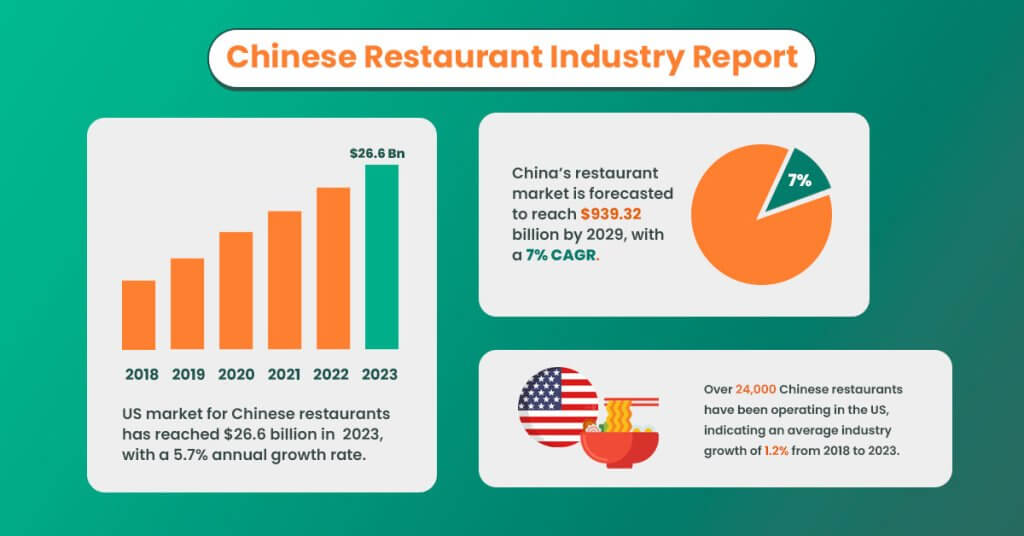
One primary step before building your business plan is to investigate the profitability and feasibility of the business you’re considering.
To help you measure this, here is a list of industry reports you should consider:
- The IBISWorld industry report highlights the total market value for Chinese restaurants in the US, which will be $26.6 billion over five years to 2023.
This has garnered a compound annual growth rate of 5.7% despite the emergence of the pandemic in 2020 and the inflation rate in 2021.
This steady growth is the result of many restaurant operators increasing their menu prices to maintain financial stability.
- BusinessWire released a 2024 China’s restaurant market, forecasting the market value to reach $939.32 billion in 2029—a 7% CAGR.
Indicators like the increasing integration of online food delivery platforms, growing interest in international and fusion cuisine, increasing company focus on digital and branding, ongoing adoption of cutting-edge restaurant technology and tools, and shifting emphasis on sustainability and responsible sourcing guaranteed the boost of its market value.
- Since 2023, more than 24,000 restaurants have been actively operating in the US, which indicates an industry growth of 1.2% on average from 2018 to 2023.
This is quite a high percentage despite the restaurant industry’s drastic shift in operations due to the pandemic.
11 critical steps to take when starting the best Chinese restaurant business
Research and plan
As you may know, doing research and careful planning saves you from wrong business decisions, especially when you’re venturing into culture-specific projects like Asian restaurants or business pursuits that require in-depth information.
So before jumping right into the business side, make sure you have equipped yourself with the knowledge and understanding of its culture and tradition.
This is essential to give proper respect and homage to locals who will visit your restaurant.
Once you have all these prepared, conduct a market analysis of local competitors (if any) and market demands.
This will provide you with data on its feasibility and profitability in the area of your choice. It will also help you identify your target demographics, customer preferences, and spending habits.
Then, create a comprehensive business plan where you define your restaurant concept and vision, including the budget, funding, and revenue projections. If you’re planning to seek outside support, this is also the right time to consider bringing in restaurant investors who believe in your concept and can help bring it to life.
Legal and financial considerations
Navigating the legal and financial aspects of your business is necessary.
Before launching it, make sure that you have complied with the regulations and standards set by your local government.
Secure the required permits and licenses, as this process is crucial for your business to operate legally in the area and avoid potential fines or closures.
On the financial side, you need startup capital to finance your business. You can acquire this through payday loans, personal savings, or having investors who can support your vision.
Pro tip: Properly budget your resources.
Whether you’re a seasoned business owner or an aspiring starter, allocating your funds correctly will save you a lot of money.
Remember, a well-structured budget helps you to manage your resources efficiently and can set a solid foundation for your restaurant’s success.
Know your location and restaurant design
Be keen on choosing a restaurant location.
A Forbes article published in October 2023 highlighted that business location can significantly impact one’s success through customer demographics.
Know that every state is unique and attracts a diverse population with different needs, preferences, and cultures.
To help you in your decision-making process, consider factors like high foot traffic, visibility, and accessibility.
Once you’ve found the ideal spot, negotiate your lease carefully, aiming for favorable terms.
When it comes to design, incorporate Chinese culture in your restaurant’s exterior and interior, creating an authentic and inviting ambiance.
Focus on a layout that optimizes the kitchen, dining area, and waiting space for efficiency and comfort.
Develop your menu

Balance traditional Chinese food with local tastes to appeal to a broader customer base.
While maintaining the authenticity of classic recipes, consider incorporating local flavors and ingredients to cater to regional preferences.
This approach ensures your menu resonates with traditionalists and those seeking a familiar twist.
Use menu engineering techniques to highlight high-margin items and create a visually appealing layout.
Develop a pricing strategy that reflects the quality and uniqueness of your offerings while ensuring portion control to manage costs and provide value to customers.
Source ingredients
Identify and partner with suppliers who can consistently provide high-quality, authentic Chinese ingredients.
Look for suppliers who specialize in Chinese cuisine and have a track record of reliability. Importing key ingredients from China might be necessary to maintain authenticity and meet your menu’s high standards.
It’s also essential to establish strong relationships with your local suppliers.
This will ensure a steady supply of fresh, seasonal produce and other essential ingredients for your restaurant.
Good rapport can also lead to better prices and more reliable deliveries, making it beneficial for your business.
Purchase equipment
Equip your restaurant with essential tools and appliances specific to Chinese cooking.
These include woks for stir-frying, steamers for dumplings and buns, rice cookers, and specialized knives for precise chopping and slicing.
Additionally, consider installing a high-powered stove to achieve the intense heat required for many Chinese dishes and a robust ventilation system to manage smoke and odor effectively.
Leverage technology like a QR code menu ordering system, self-service kiosk, or digital board for streamlined workflow.
Hire and train staff

Identify the key positions required for your restaurant. This might require you to hire a chef, kitchen staff, and wait staff to complete the initial group for your opening.
Create a detailed restaurant manager job description along with job descriptions for other key roles, outlining the skills and experience needed to help you run the business efficiently.
Use various platforms, such as social media job board sites, for your hiring postings to reach the candidates you’re looking for.
Remember to have comprehensive training programs for all of your staff members. This will enhance their skills and boost morale and job satisfaction, leading to a more cohesive and capable team.
Marketing and promotion of your Chinese restaurant
A strong brand identity is essential for your business to stand out in this competitive restaurant industry.
To achieve this, develop a unique logo, name, and theme that reflect your restaurant’s essence and can resonate with your target audience.
Ensure consistent branding across all platforms, from your website and social media to physical materials like menus and signages, to build recognition and trust.
Combine traditional marketing strategies, such as distributing flyers, participating in local events, and forming partnerships with local businesses with robust digital marketing efforts.
Take New Years, for instance. This is one of the most profitable time of the year, so make sure to plan an outstanding Chinese New Year restaurant promotion campaign months before the actual date.
Once done, maintain an engaging website and active social media presence and encourage online reviews to reach a wider audience.
Develop an enhanced customer service and experience
Outstanding customer service is essential to your restaurant’s success since it dramatically impacts patron loyalty and satisfaction.
Providing expert employee training on managing complaints and comments guarantees that any of your customers’ complaints are immediately fixed, creating a good impression on your customers.
Creating a memorable dining experience requires considerable planning to represent your restaurant’s distinct style and appeal. So, curate the ambiance, presentation, and hospitality that reflect your business’s overall personality.
Alongside the excellent dining experience is customer service.
Engage with your guests in person and through follow-up interaction. This can build a loyal customer base and ensure they will return for the exceptional service and experience your restaurant constantly provides.
Monitor your Chinese restaurant’s performance
To determine whether your business thrives, you should regularly monitor your performance metrics.
Track your sales to identify peak times and best-selling items. This will help you make informed decisions about staffing and inventory.
Measure customer satisfaction through surveys, reviews, and direct feedback to understand areas of improvement and strengths.
Pay attention to inventory levels to manage costs and reduce waste. Ensure that you always have the necessary ingredients without overstocking.
Sustainability practices
Implement eco-friendly practices to reduce your restaurant’s environmental footprint.
Focus on reducing food waste by optimizing inventory management, repurposing leftovers, and donating surplus food to local charities.
Use sustainable packaging made from biodegradable or recyclable materials to minimize waste.
If you have extra budget, invest in energy-efficient appliances, LED lighting, and water-saving fixtures to reduce energy consumption and operational costs in the long run.
5 things to do to sustain an Asian restaurant
Now that you have the preliminary information, we’ll discuss what you should do to sustain a good standing in the market.
Consistency in quality
To sustain this business, maintain every dish to its highest quality and authenticity over time.
Consistency in taste, presentation, and ingredient quality builds customer trust and satisfaction, which can encourage repeat visits and positive word-of-mouth promotions.
Conduct routine training for chefs and kitchen staff to uphold these standards, and taste dishes periodically to assess whether they meet your restaurant’s quality benchmarks.
Effective customer engagement
Engage with your customers by implementing loyalty programs that reward their frequent visits.
You can personalize customer interactions through targeted email newsletters, special offers, and exclusive events.
If you receive feedback, respond promptly and thoughtfully. This shows that you value their opinions and are committed to improving your services.
Through this, you’re guaranteed to attract new patrons, retain existing ones, and build a loyal customer base that drives long-term benefits.
Financial management
The foundation of significant business decisions is how well you manage your finances.
Thus, financial management is essential for achieving your restaurant’s long-term sustainability and profitability.
Start by developing a comprehensive budget that outlines all projected expenses and revenues, including costs for ingredients, labor, rent, utilities, marketing, and other operational expenses.
Review financial statements, profit and loss reports, and balance sheets regularly to monitor your financial health and identify areas for reducing your total costs.
Adaptability and innovation

Whether you’re looking for a traditional or modern approach in your restaurant, it’s crucial that you adapt and explore various innovations to keep up with the evolving market.
Stay attuned to industry trends, customer preferences, and emerging technologies to keep your offerings fresh and relevant.
Meticulously analyze customer feedback to understand their evolving tastes and expectations. Use this information to make meaningful changes, like updating your menu themes or improving your offerings and services.
You can introduce new dishes or give a twist to the traditional ones to accommodate varying preferences.
Or incorporate technologies in your workflow like ordering software or self-service kiosks to expedite the process efficiently.
Community engagement and reputation management
Building solid relationships with the local community is vital for sustaining your restaurant.
Actively participate in community events like Asian or Chinese food festivals, cultural celebrations, and local markets to increase your visibility and demonstrate your commitment to your area.
You must also maintain a strong reputation for attracting and retaining customers.
Monitor online reviews and social media mentions to stay informed about what customers say. Make sure to respond to reviews—both positive and negative—in a timely and professional manner.
Thank customers for their positive feedback and address any complaints or issues with empathy and commitment to resolve them.
List of popular Chinese food business menus to add to your offerings
Peking Roasted Duck
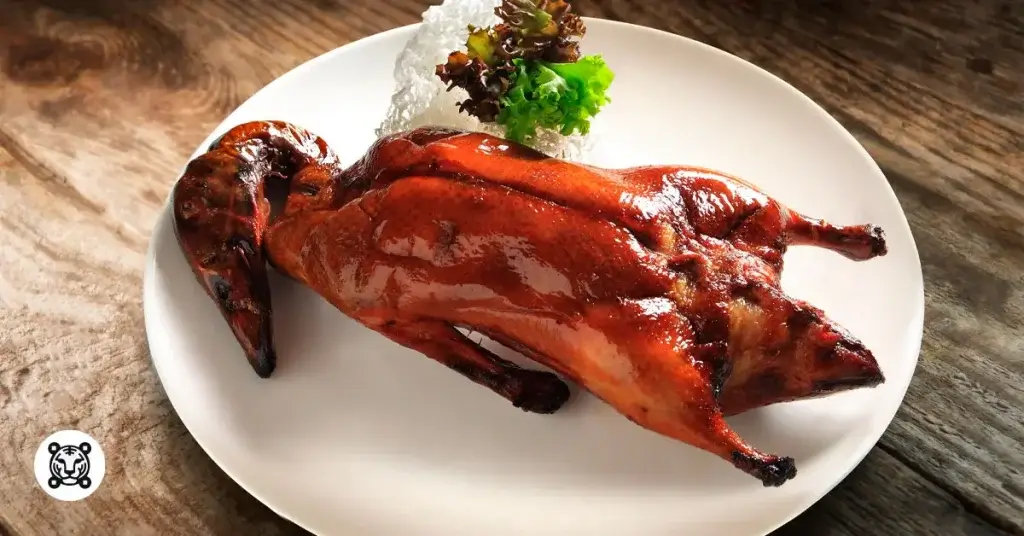
This famous dish from Beijing is at the top of the list of roosters as it is considered one of China’s national foods.
It is savored for its thin and crispy skin and is often served with pancakes, sweet bean sauce, and sometimes cucumber and scallion.
Kung Pao Chicken

This classic Sichuan dish is known for its bold flavors and vibrant presentation.
It consists of marinated diced chicken and then stir-fried with peanuts, vegetables, and dried chiller peppers.
The sauce, made from soy sauce, vinegar, sugar, and Sichuan peppercorns, gives the dish its characteristic sweet, sour, salty, and spicy taste.
Sweet and Sour Pork
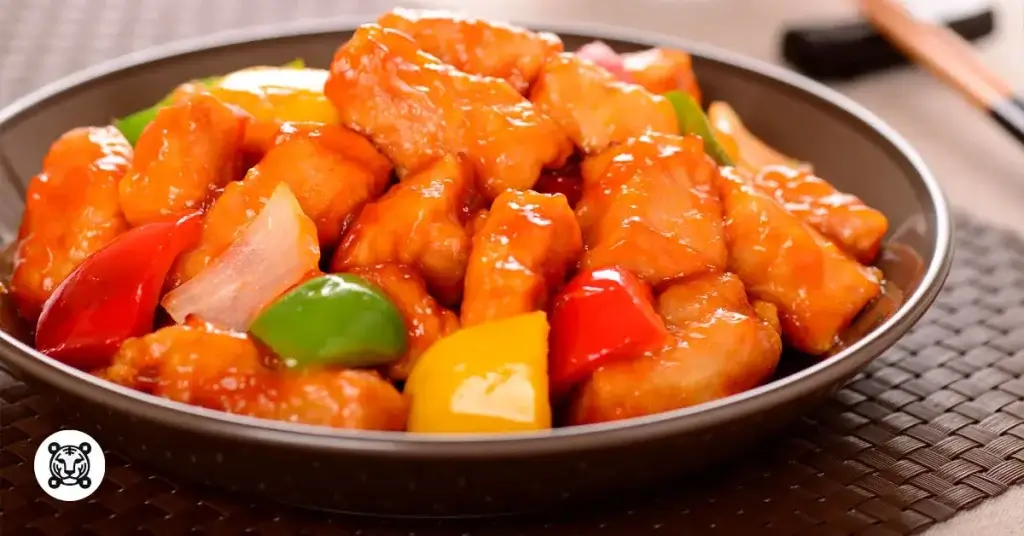
Sweet and Sour Pork is a beloved dish in Chinese cuisine, known for its tantalizing contrast of flavors.
It typically features bite-sized pieces of pork that are battered and deep-fried until crispy.
The pork is then tossed in a vibrant sauce made from vinegar, sugar, ketchup, and soy sauce, creating a perfect balance of sweetness and tanginess.
Hot Pot
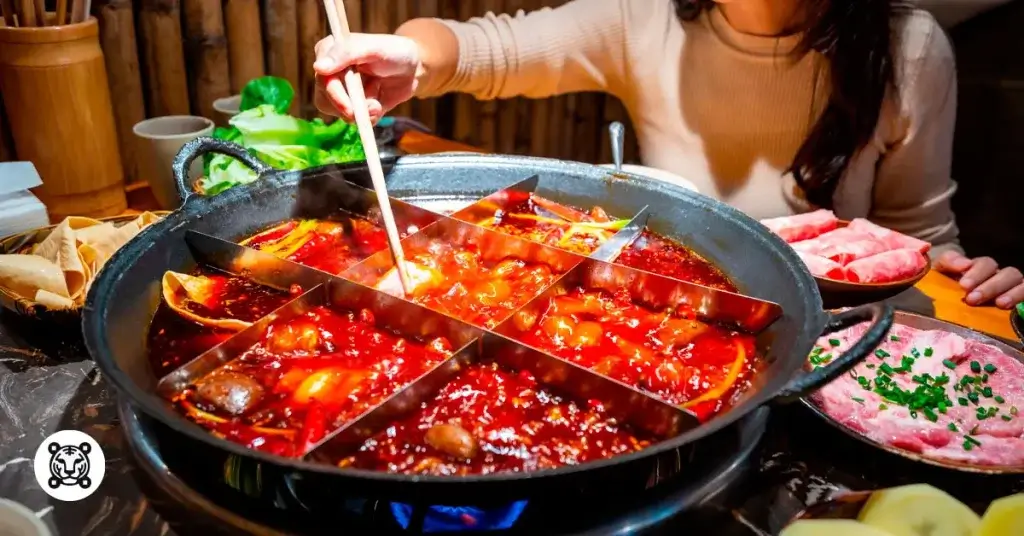
This is also known as Chinese fondue, a popular communal dining experience.
A large pot of simmering broth is placed at the center of the table, and diners cook various raw ingredients in the broth.
The ingredients can include thinly sliced meats, seafood, vegetables, tofu, and noodles.
Dim Sum

Dim Sum is a Chinese dish with a wide range of small foods served in steamed baskets or on small plates.
It’s traditionally enjoyed as a brunch, often accompanied by tea, hence the term Yum Cha (drinking tea).
The variety of dim sum dishes can include dumplings, buns, rolls, cakes, and other savory and sweet items.
Dumplings

Dumplings are versatile and an integral part of Chinese cuisine. They are enjoyed in various forms across the country (and around the world).
They consist of a dough wrapper filled with ingredients like meat, vegetables, or a steamed combination of both.
You can boil, steam, or fry them, providing a different texture and flavor.
Mapo Tofu

This is another signature Chinese food from the Sichuan province, renowned for its bold, spicy, and numbing flavors.
It has soft tofu cubes set in a vibrant, oily sauce made with doubanjiang (fermented broad bean and chili paste), douchi (fermented black beans), minced pork or beef, and a generous amount of chili oil and Sichuan peppercorns.
The silken tofu, spicy sauce, and numbing peppercorns make this a favorite among spice enthusiasts.
Wonton Soup

This comforting and delicate soup is enjoyed throughout its home country and in Chinese communities worldwide.
Wontons are dumplings filled with minced pork and shrimp, seasoned with ginger, garlic, and sesame oil.
They are wrapped in thin dough wrappers and then boiled until tender. The wontons are served in a clear broth made from chicken or pork bones, often garnished with scallions and sometimes bok choy or other greens.
Mala Xiang Guo
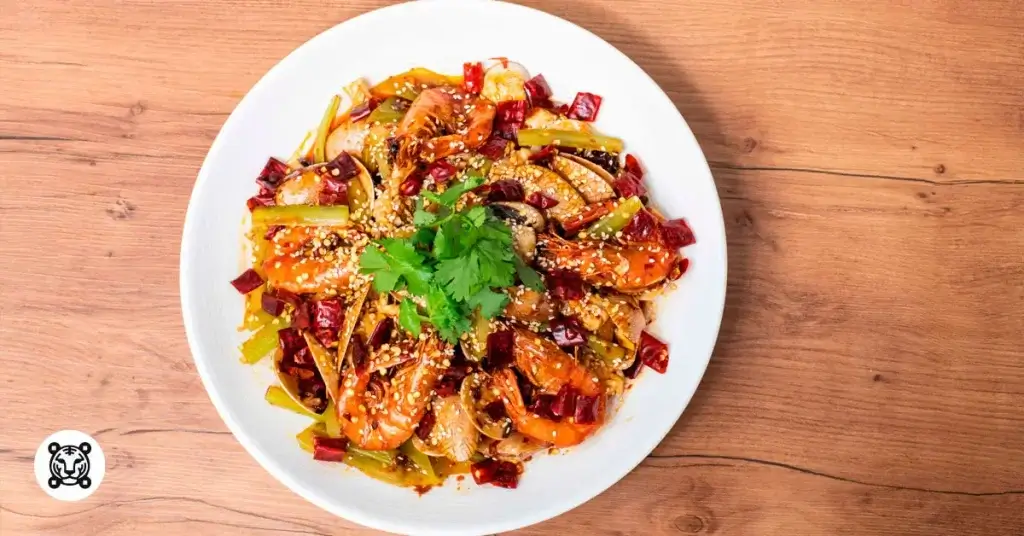
Mala Xiang Guo is a dry stir-fry dish that has gained popularity for its intense and addictive flavors.
“Mala” refers to the numbing and spicy sensation from Sichuan peppercorns and dried chilies, while “Xiang Guo” means fragrant pot.
The dish consists of various ingredients, such as meats, seafood, tofu, and vegetables, stir-fried together with a mala sauce.
Advancing your restaurant operations with QR code menu technology

One factor that keeps customers returning to a restaurant—aside from good food and a relaxing dining environment—is the quality of the service.
To offer that, you have to have efficient operations to begin with.
Leveraging technology like MENU TIGER QR digital menu QR code software can be your starting point to building an efficient, cost-saving, and streamlined workflow system to give your customers the best service.
Here are some of the features it offers to help you in your operations:
Waiter call button system
Quick responses to customers’ needs show that your staff is attentive and dedicated to providing a positive experience when dining in your restaurant.
Whether they ask for additional tissues or address concerns about their food, giving immediate attention significantly enhances customer satisfaction.
With MENU TIGER’s restaurant waiter call button system, your staff will be notified of these requests even during peak hours.
All they have to do is input their requests on their smartphones, which are then displayed directly to the software.
Digital restaurant menu QR code for ordering and payment processes
Aside from having the traditional printed menu, you can also have an alternative option, using a digital menu QR code, for those who want to take out orders.
Customers can access your menu by scanning the QR code, placing their order, and paying for it with the e-payment method.
This takes away the need for them to wait in line at the counter, allowing them to relax in the designated waiting area.
Pro tip: Providing steps on how to scan a menu QR code will help those customers, especially elderly, who haven’t had any experience of using it.
This level of consideration towards your customers can make them feel valued, building trust and loyalty to your brand.
Self-service kiosk configuration
A self-service kiosk is a good choice if you’re looking for ways to combine a traditional and modern approach in your operations.
What’s good about this is that MENU TIGER software can be configured into your kiosk, further advancing your operations.
One of the benefits of QR code menu software is that your customers can automatically order and pay through the kiosk. At the same time, they can access other services through QR codes placed on their tables.

Let’s start planning to create a culture-centered dining haven
Opening the best Chinese restaurant can be tricky and daunting, especially in a foreign country.
Because food is deeply connected to their culture and tradition, you have to be meticulous about authenticity and cultural appropriation.
That’s why it requires more effort than your usual restaurant.
Aside from that, having this business you have to use your creativity to perfectly blend traditional with modern practices to be successful in this venture.
To achieve this, technology like MENU TIGER QR code menu software, which requires only a tablet or a laptop, comes to mind.
This way, you can design your space with a focus on traditional aspects while having a modern system to navigate the whole process from ordering to paying.
This smart menu software offers indispensable features and benefits. So, it’s best to visit the website, sign up and explore this technology with a forward-thinking mind.
FAQs
Chinese cuisine is renowned for its rich diversity and complexity. It features distinct regional flavors, such as the spicy heat of Sichuan, the mild sweetness of Cantonese, and the refined delicacy of Jiangsuu dishes.
It balances fundamental tastes—sweet, sour, salty, bitter, and umami—through varied cooking techniques such as stir-frying, steaming, and braising.
Many popular Chinese restaurants across the United States are known for their authentic cuisine and unique dining experiences.
Here are some notable ones:
-Din Tai Fung – is famous for its soup dumplings and consistently high-quality dishes.
-P.F. Chang’s – is a well-known chain offering a blend of traditional Chinese and American cuisine.
-Joe’s Shanghai – is renowned for its soup dumplings and flavorful dishes.
-Mission Chinese Food- is known for its creative and contemporary take on Chinese cuisine.
-Panda Express – is a fast-casual restaurant chain known for its American Chinese menu.
-Hakkasan – offers a fine dining experience with modern Cantonese dishes.
-Jiang Nan Spring – celebrated for its authentic Jiangnan cuisine and dumplings.
-Xi’an Famous Foods – Specializes in the bold flavors of Xi’an, known for its hand-pulled noodles and spicy -dishes.






